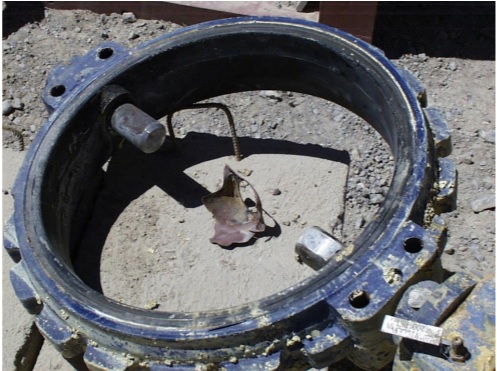Author: CGIS (CG Industrial Specialties)
Our decades of experience working with Severe Service Valves (SSVs) in Chemical Industries have taught us many important lessons. Below are three we hope you’ll consider when selecting your next valve.
Lesson 1 – Consider the Whole Application
The photograph below is a testament that you get what you pay for, and if you don’t consider the whole of the application you may suffer greatly. In 1995 a new copper mine was built in Chile. It was designed to use 85 g/l weak sulphuric acid to irrigate a heap of copper oxide ore. The acid was sprayed over a huge pile of crushed ore which dissolved the copper into solution where it was later electro-won out into pure copper cathodes. This type of mine and process plant is known as a Heap Leach-SXEW (solvent extraction, electrowinning).
The original process designers selected titanium as their corrosion resistant material of construction for the valves used to direct and isolate the weak acid. These 24” valves cost upwards of $60,000 each originally. When a small brownfield project later arose, the local project team balked at the price and decided to investigate alternatives. They checked the corrosion charts and saw that a Buna-N resilient seated ductile iron butterfly valve with a PVDF coated ductile iron disc was rated A for the temperature and 85 grams/litre concentration of sulphuric acid. They were under $6,000 each, a far lower cost that was irresistible for the buyer to ignore.
The problem is that they only lasted a few months because they were not used only as full Open or Closed isolation valves; besides being used to isolate the centrifugal pumps for maintenance, they were also used on the discharge of the pumps to assist the pump during start-up to develop head pressure. That required them to be placed in the near closed position. Unfortunately the velocity of the acid that was developed while nearly closed was so high it physically removed the thin PVDF coating covering and protecting the ductile iron disc. This exposed the iron disc and the acid simply dissolved it. Of note, the originally supplied titanium valves are still in service 22 years later. Sometimes buying cheap costs more.
Lesson 2 – Use Properly Processed Materials
At a recent valve conference in Dusseldorf, some of the global audience heard a presentation from the QA manager of a major global chemical company where he identified a significant number (more than 35%) of the Material Test Reports (MTRs) for valves and fittings they purchased during the year were incorrect, missing, contained obvious errors and in some cases were fraudulent. If this is a normal occurrence, then the
confidence we have in the valves we use in severe services is surely mistaken.
This statement hit a personal nerve of mine when in 2006 I was hauled before a distraught client in Australia who had a number of valve issues due to the valves we had supplied leaking sulphuric acid all over his plant.
The resulting investigation brought our attention to the knife gate valves we had provided. The manufacturer used castings to make the valve bodies and wrought plate to make the blade. We had selected the casting as ASTM A890 Gr 5a, a Super-Duplex stainless steel well suited for the 70-80°F temperatures of the 40 weight percentage sulphuric acid in the Counter Current Decantation circuit of this hydrometallurgical facility.
For several years these valves worked flawlessly. The client became very comfortable and decided to try them in an upstream, more challenging process, one where the temperatures reached 200°F. This is where the problem started. As you will note in the Isocorrosion Chart for Sulphuric Acid, this acid creates some interesting variations based upon the wt % and temperature. At the higher temperature, the material was no longer as resistant to corrosion.
The investigation also exposed the potential for issues using the A890 ASTM recipe. The non-destructive testing is a little weaker than the more popular ASTM A995 used today. Metallurgical testing showed that the castings were improperly heat treated. While at the lower temperatures, the acid wasn’t as aggressive at exposing the poor manufacturing, but at the higher temperature, the flaws were exposed and the valve failed to contain the acidic solution.
It’s other case of you don’t know what you don’t know and exposing us to this issue caused us to re-evaluate our QA systems including purchasing. Key vendors were requested to provide better control of the vendor data so that we could eliminate or at least greatly reduce errors that could lead to future valve issues.
Of interest, the gate material which was made from plate (wrought UNS S32750) was little affected by either temperature. This is not to imply that wrought materials are better than cast ones, only that properly processed materials are what’s really important.
Lesson 3 – Don’t Ignore the Importance of Plastics
Metals are not the only material of construction used to fight against corrosion. Plastics and elastomers are also effective allies to protect against corrosion from a particular chemical or chemical process. The invention of fluorocarbons like Teflon™ (polytetrafluoroethylene) and variants has given the valve industry a wonderful family of extremely corrosion resistant materials.
Valves for corrosive services are often lined with one of the fluorocarbons, normally Teflon™ PFA, a perfluoroalkoxy copolymer which can fully isolate the valve body from the process medium. These plastic materials don’t corrode like metals, but can and do allow fluids to permeate them. Thus the quality of their manufacture to reduce the permeability, the type of liner, how it is anchored into the body, as well as the thickness of the lining are keys to preventing damage and failure of the less-noble and generally noncorrosion resistant valve bodies which provide the application’s pressure containment and retention.
Very few solid plastic valves have the strength to withstand the needs of even the lowest ASME B16.34 Class 150 pressure retaining requirements and are typically rated to a maximum of 225-psig or lower at ambient temperatures. Lined metal body valves are available fully rated to ASME Class 150 and up to and
including Class 300, 720-psig at ambient temperatures. These alternatives to solid metallic valves often offer significantly reduced acquisition costs over high alloy valves and can provide equivalent long lasting service lives if selected and operated correctly. Of course, the maxim “the application dictates the valve” applies and it is incumbent on the valve selectors to consider all aspects of the valve requirements.
A challenge for plastic lined valves has been that there are no industry Standards that gave guidance on what the minimum thickness should be or on any of the other key manufacturing details that made the valve a successful piece of process equipment.
For a Teflon™ PFA lined weir-style diaphragm valve, a typical 3mm thick body liner is the normal and generally sufficient protection for the ductile iron body. This rigid liner is formed over the weir, which serves as the base seat for the moving diaphragm seal which together provides the isolation. Due to the relatively inflexible and nonresilience of Teflon™, the diaphragm consists of a thinner layer cushioned by an elastic resilient material such as EPDM or Viton™.
This combination diaphragm seal must be able to flex multiple times without distortion or damage. Yet there is a line between how thin the corrosion resistant liner should be to allow multiple flexing and how immune it is to the stress caused by the closure of the handwheel and that rotary to linear torque to thrust. Too much torque will cause the PTFE to cold flow and weaken perhaps to a point where the protective liner is compromised and the liner is torn exposing the less resistant elastomer cushion to the process media as well as an uneven sealing surface that allows leakage even while the valve is fully closed.
When it is impractical or impossible to limit the closing torque’s potential for damage, simply changing valve design can be the obvious solution; turn multi-turn linear force into quarter-turn rotary action as shown in the lined ball valve.
Thankfully MSS will shortly publish Plastic-Lined Ferrous Metal Valves as a Standard Practice. The scope covers plastic-lined ferrous metal valves intended primarily for conveying corrosive fluids. This new tool will recommend minimum liner thicknesses, grades and formulations of plastic liners including PFA, PTFE, PVDF, PP and UHMWPe, liner anchoring, inspection and testing.
Summary and Future Outlook
The valve industry is working to provide better information to ensure the correct selection of SSVs and the proper language to nominate the valve so that it can function in service and meet or exceed our expectations. We have discovered the need for more details on the actual process dynamics including the percentage of time spend during different dynamic conditions as well as upsets, and to consider what those dynamic situations are doing that could damage the function of the valves, whether immediately or over time as the sum of the damage adds up.
There is a place for SSVs just as there is a place for GPVs and knowing where to draw that line is essential in obtaining the best, safest and lowest cost valve solutions. In the coming months, we will see better tools for identifying SSVs, including new Standards of SSV testing, defining SSVs, Standard Practices for corrosion
resistant lined valves and deeper knowledge that will assist us all in providing better valves for the most challenging applications.
Our exposure over the last five decades to a wide range of industrial applications in all of the regions of the world has provided us with an appreciation that communication is a key aspect of success and without it, of failure. Industry’s acceptance of terms like high-performance and tight shut-off gave false confidence and assurance that valves will work in difficult applications. We have begun to rid ourselves of subjective
terminology and bring objective and measureable performance to the task. This greatly enhances our chances of success.








